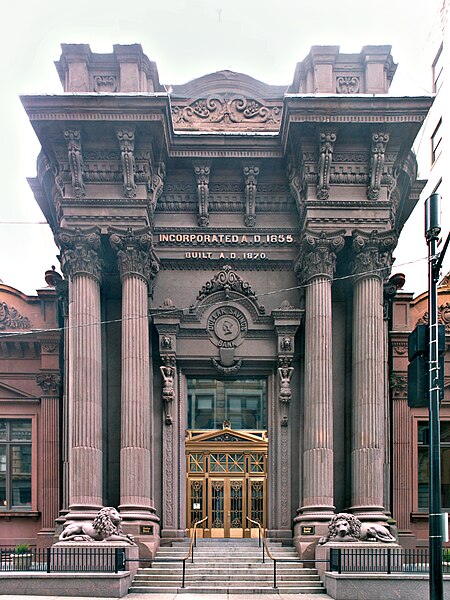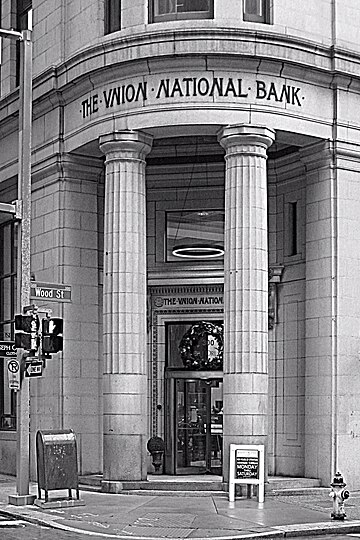
The titanic columns of the Mellon Institute reflected in the Software Engineering Institute.




“Make no little plans,” said Daniel Burnham; “they have no magic to stir men’s blood and probably themselves will not be realized.” The Chicago Tribune tells us the interesting story of the long search for the original source of that quotation, and the determination that it was in fact what Burnham said. It is probably the second-most-famous quotation from an architect in history: only Louis Sullivan’s “Form follows function” has been heard more often.
Outside Chicago, Pittsburgh was where the great Burnham was most prolific. Many of our most famous buildings—the Oliver Building, Penn Station, the Frick Building, and a good number of others—are by Burnham. Most of them are colossal. But the old Union Trust Company building—now the Engineers’ Society of Western Pennsylvania—was his first work here, and it is on a small scale. Small, but rich and perfect in its way. The front is a traditional Doric temple; the treatment of the top storey behind the pediment seems to enclose the temple in its own perfect world, insulated from the ugly realities of Fourth Avenue commercialism around it. It was built in 1898, and it can be seen as an answer and a rebuke to the tasteless extravagance of Isaac Hobbs’ 1870 Dollar Bank building across the street.

This little bank on Fourth Avenue was originally designed by Alden and Harlow. The central section has been ruthlessly mutilated, with the elegant arch replaced by a cartoon suggestion of an arch. For reasons unknown, much of the rest of the building was left untouched (although it is pretty clearly missing its top), and the details there are enough to make it worth our while to stop and admire them.


Of course there are lions. How could there not be lions?


The adjective “tasteful” does not naturally attach itself to this structure. It has the look of a building specified by a banker who hired an expensive architect and was determined to wring every cent of his money’s worth out of the details. It is magnificent in a slightly horrifying way: this is the kind of monstrosity that was in the minds of the modernists when they condemned all things Victorian. Old Pa Pitt would not change a single swirl or swag or grotesque half-vegetable naked lady.
The architect in question was the firm of Isaac H. Hobbs & Sons from Philadelphia. Isaac H. Hobbs was a kind of celebrity architect. He was familiar to the thousands of ladies across our fair land who read Godey’s Lady’s Book, the premier fashion magazine of the middle 1800s: every month, Hobbs contributed a design for an elaborately Victorian residence for the lady readers to drool over. It was something like having a regular segment on a popular daytime talk show today. According to the Pittsburgh History and Landmarks Foundation’s Fourth Avenue walking tour (PDF), Hobbs designed a number of houses around Pittsburgh, but Father Pitt does not know any of them; he wonders whether they were original designs, or whether they were adaptations of the many designs published in Godey’s.

It appears that the crust of 150-year-old ornamentation requires some stabilization: netting is stretched over the top half of the building at the moment.


A splendid banking hall with façades by Frederick Osterling. The Wood Street one above is one of his late works, from 1926. Many of the banks along Fourth Avenue went for height, building some of the first skyscrapers; the Colonial Trust Company went for length. Its main hall extends all the way through from Fourth to Forbes, with elaborate façades at both ends; it later extended a perpendicular arm to Wood Street. Below, the Fourth Avenue façade from 1902, also by Osterling. We can see how much his ideas of classical architecture had changed in 24 years. In 1902 he chose the Corinthian order and elaborated it with every kind of ornament of which classical architecture is capable; in 1926 he chose the Ionic order and kept the ornamentation to a minimum.


This is very definitely a corner building, and architects MacClure and Spahr made the corner the most identifiable thing about it. That curved corner runs all the way up to the top, and the main entrance is right on the corner of Fourth and Wood.
Notice the capitals on those prominent columns. How do you adapt square Doric capitals to a fairly tight curve? Making them octagonal is a solution that might have given Vitruvius a stroke, but works very well in this context.
The building is now luxury apartments under the name “The Carlyle.”

The classical style of this church, which is now the cathedral for the Metropolis of Pittsburgh, is quite unusual for a Greek Orthodox church. Greek Christians do not usually build in a Greek classical style—and the style of this church, with the prominent arch in the front, is more Roman than Greek. The explanation is that it was built for Methodists; the Orthodox congregation bought it from them.

Even if you don’t know much Greek, you can probably guess that this is the name of the church in Greek: “St. Nicholas Greek Orthodox Cathedral Church.”

One of the splendid Ionic capitals that hold up a front of which Vitruvius would have approved.